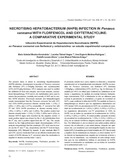Mostrar el registro sencillo del ítem
Necrotising hepatobacterium (NHPB) infection in Penaeus vannamei with florfenicol and oxytetracycline: a comparative experimental study
| dc.rights.license | http://creativecommons.org/licenses/by-nc-sa/3.0/ve/ | |
| dc.contributor.author | Morales Covarrubias, María Soledad | |
| dc.contributor.author | Tlahuel Vargas, Lourdes | |
| dc.contributor.author | Martínez Rodríguez, Irma Eugenia | |
| dc.contributor.author | Lozano Olvera, Rodolfo | |
| dc.contributor.author | Palacios Arriaga, Juan Manuel | |
| dc.date.accessioned | 2012-03-05T21:53:52Z | |
| dc.date.available | 2012-03-05T21:53:52Z | |
| dc.date.issued | 2012-03-05T21:53:52Z | |
| dc.identifier.issn | 0798-2259 | es_VE |
| dc.identifier.uri | http://www.saber.ula.ve/handle/123456789/34600 | |
| dc.description.abstract | The present study is aimed to necrotising hepatobacterium (NHPB) infection, development in juvenile of Penaeus vannamei with florfenicol (FF) (1.000g/kg biomass) and oxytetracycline (OTC) (6.070 g/kg biomass). HPLC analysis was used to confirm the antibiotics in food and samples, wet mount analysis, conventional histopathology, PCR and in situ hybridization were used to assess the prevalence, mortality and severity of NHP and to confirm NHPB infection. Wet-mount analysis and histopathological results demonstrated that the Penaeus vannamei fed with OTC had 100% NHPB prevalence disease severity index 1 (10%), 2 (28%), 3 (35%) and 4 (27%); meanwhile, P. vannamei fed with FF had 100% NHPB prevalence at disease severity index 1 (16%), 2 (36%), 3 (20%) and 4 (28%). The positive control had disease severity index 1 (10%), 2 (10%), 3 (80%) and 4 (0%); no disease NHP-B signs were revealed by the negative control. A weak positive signal was shown by the in situ hybridization from the 9th day, and a positive signal from the 15nd day. The results derived by the High-performance liquid chromatography (HPLC) analysis demonstrated that the maximum OTC level was in muscle (on the 6th and 7th day, respectively) and the FF level in hepatopancreas (HP), followed by muscle. It was conclude that FF and OTC used in medicated feed as an effective treatment in the control of NHPB disease in P. vannamei when the medication is supplied in disease severity index 1 and 2. | es_VE |
| dc.language.iso | es | es_VE |
| dc.rights | info:eu-repo/semantics/openAccess | |
| dc.subject | NHPB | es_VE |
| dc.subject | Florfenicol | es_VE |
| dc.subject | Juvenile | es_VE |
| dc.subject | Oxytetraciclina | es_VE |
| dc.subject | Penaeus vannamei | es_VE |
| dc.title | Necrotising hepatobacterium (NHPB) infection in Penaeus vannamei with florfenicol and oxytetracycline: a comparative experimental study | es_VE |
| dc.title.alternative | Infección experimental de hepatobacteria necrotizante (NHPB) en Penaeus vannamei con florfenicol y oxitetraciclina: un estudio experimental comparativo | es_VE |
| dc.type | info:eu-repo/semantics/article | |
| dc.description.abstract1 | El presente estudio tuvo como objetivo la infección y desarrollo experimental de la hepatobacteria necrotizante (NHPB) en juveniles de Penaeus vannamei, con florfenicol (FF) (biomasa 1.000g/kg) y oxitetraciclina (OTC) (6,070 g / kg de biomasa). El análisis por HPLC se utilizó para confirmar los antibióticos en alimento y organismos, los análisis de montaje húmedo, histopatología convencional, PCR e hibridación in situ se utilizaron para evaluar la prevalencia, la mortalidad y el grado de severidad de NHP y para confirmar la infección NHPB. Por análisis en fresco e histopatología se observó que los organismos alimentados con OTC tenían 100% de prevalencia de NHP con un índice de severidad de la enfermedad de 1 (32%), 2 (28%), 3 (35%) y 4 (27%) y los organismos alimentados con FF presentaron el 100% de NHPB con un índice de severidad de la enfermedad de 1(16%), 2 (36%), 3 (20%) y 4 (28%). El control positivo presentó un índice de severidad de la enfermedad de 1 (10%), 2 (10%), 3 (80%) y 4 (0%), no se detectó NHPB en ninguna muestra del control negativo. Por hibridación in situ se observó una señal positiva débil al noveno día de infección y una señal intensa después del quinceavo día. Los resultados por cromatografía líquida de alta resolución (HPLC) muestran que el nivel máximo de OTC fue al sexto y séptimo día de tratamiento en músculo y el nivel máximo de FF se detectó en hepatopáncreas, seguido por el músculo al tercer y cuarto día de tratamiento. Los resultados de este trabajo muestran que los dos antibióticos, inhiben el crecimiento de NHPB, cuando la medicación se suministra con un índice de severidad de la enfermedad entre 1 y 2. | es_VE |
| dc.description.colacion | 72 - 80 | es_VE |
| dc.description.email | marisol@ciad.mx | es_VE |
| dc.description.frecuencia | Bimestral | es_VE |
| dc.identifier.depositolegal | 199102ZU46 | es_VE |
| dc.subject.institucion | Universidad del Zulia (LUZ) | es_VE |
| dc.subject.institucion | Universidad de Los Andes (ULA) | es_VE |
| dc.subject.publicacionelectronica | Revista Científica | es_VE |
| dc.subject.seccion | Revista Científica: Vida Silvestre | es_VE |
| dc.subject.thematiccategory | Medio Ambiente | es_VE |
| dc.subject.tipo | Revistas | es_VE |
| dc.type.media | Texto | es_VE |
Ficheros en el ítem
Este ítem aparece en la(s) siguiente(s) colección(ones)
-
Revista Científica - 2012- Vol. XXII - No. 001
Enero - Febrero 2012


